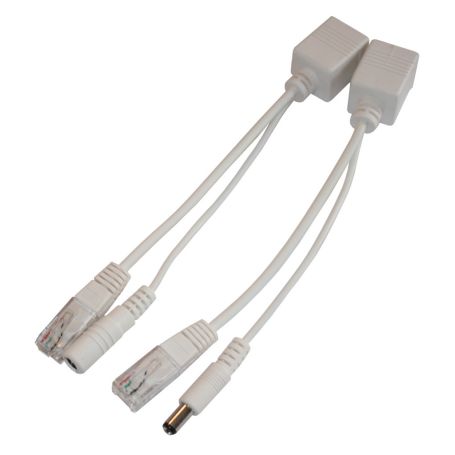RJ45 Passive PoE power injection - cable Kit
Carry power together with the data along your RJ45 cable
Payments are secured by LyraCollect, a French payment collection company.
It is possible to delivered to your home, to a pick-up point or picked up by appointment at MCHobby
We prepare, pack and ship your orders with great respect and care.
Passive power injection on RJ45 Ethernet cable
This kit allows to inject a power supply on an RJ45 network cable and to recover this power supply on the other side.
In short, a single cable for power + data... enough to simplify the power of your Raspberry-Pi or project connected on the NET.
The exact name of such product is "Passive PoE injection" or "Passive Power Over Ethernet Injection".
This product is added to our range as part of BirdBox projects allowing to place a Pi + Camera in a nest box without having to carry a power cable to the nest box and Raspberry-Pi (often outside).
Advantages:
This extremely simple process brings the advantage of great flexibility to power your projects... no need for a battery or a power plug near your project... where the network cable passes, your project will be powered :-)
Concentration of your power sources at a single central point... just beside the network connectivity :-)
Need to do a HARD RESET of all your projects? No problem, you turn off the power at its starting point, wait a few seconds and then reconnect. Unorthodox but perhaps realized by anybody and doesn't require any technical knowledge to be realized (it's known, when the system derails to death, one is never around!)
Disadvantage:
Transfer limited to 10/100Mbs. The Gigabyte using all the Ethernet cable pairs, you will not be able to use this PoE injection kit and keep Gigabyte transfer. Smart routers will downgrade to 100Mb.
Tip & trick:
You can accompany this cable with a couple of adapters to facilitate your power connections.
The MALE power adapter with terminal block and the FEMALE power adapter with terminal block are fully compatible with this product.
To keep an eye on:
You just have to predict the voltage drop of your power supply in the network cable! The longer the cable, the greater the voltage drop. Of course, it also depends on the current needed to power your project (forget your toaster, hair dryer, etc).
We are talking here about a relatively reasonable voltage drop (from 0.2 to 1.5V depending on the conditions) there's nothing to write home about except for more fussy projects on power supply. As an example, Raspberry-Pi accepts 5.25V, 5V but buggy to death at 4.90 volts (untimely resets).
Rest assured, there are simple tips to work around the inconvenience of this voltage drop.
Content
- 1 x incoming cable with:
- an RJ-45 connector (to connect to your router or Ethernet hub)
- a 5.5mm female DC plug (for connecting the power source)
- 1 x cable coming out with:
- an RJ-45 connector (to connect your project/Pi on the Ethernet network)
- a 5.5mm male DC plug (to power your project with electricity)
- RJ45 connector 10/100MBit/s
- PVC, white or black depending on the supply
- 2A max
Transport energy efficiently with a Passive PoE cable
To get around the problem, you have to use a process comparable to that used on electrical distribution networks. Before receiving your power supply at home (in 220/240V alternative), the energy is transported on very high voltage lines (up to 735 000 Volts) before lowering the voltage to 220/240V for distribution in urban areas. Rest assured, we will not inject such a voltage on our cables but we will use a similar system with for example 12V that we will then regulate to 5V or more at the level of our project (see our different regulators also available in our section "power supply").
Why use a higher voltage?
Well because it reduces the current needed to carry the same amount of energy. And as previously said the voltage drop directly (1) of the length and (2) of the current (purists will forgive me this shortcut of the law of Pouillet).
For example, let's take a Pi B Plus + project consuming 1.2A at 5 Volts. For an Ethernet cable with a resistance of 91.5 milliOhms per meter (source), this makes us a resistance of 1.92 Ohms for 25m of cable (I want to go in the cabin at the bottom of my garden).
The voltage drop in the cable will be U = R x I = 1.92Ohms x 1.2A = 2.3 Volts! It is certain, the Pi, it will not boot.
And if we used 12 Volts on the cable?
Carry 1.2A at 5V represents a power of P = U x I = 5 x 1.2 = 6 Watt.
To carry the same power of 6W in 12 Volts, we have 6W = 12V x I --> I = 6W / 12V = 0.5 A.
It takes less than half the current to carry the same power! The voltage drop in our same cable of 25m is U = R x I = 1.92Ohms x 0.5A = 0.96V.
At the other end of the cable, we still have 11.04V available (since there is a voltage drop of 0.96V). A voltage sufficient to produce a voltage of 5V using a switching regulator 5V 600mA, Step Down, D24V6F5 or switching regulator D15V70F5S3, 3.3/5V 7A, Step-Down (for demanding project) or other.
Tutorial
- This Pi-BirdBox tutorial (instructable, English)
- Our tutorial on DC-DC regulators (mchobby.be, French)










